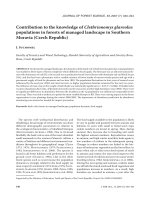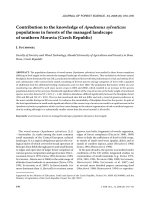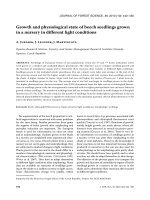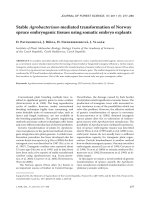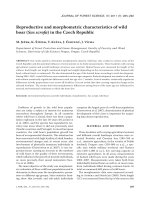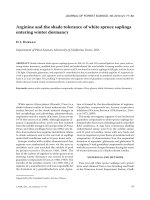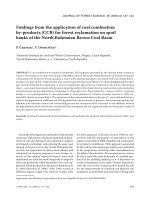Báo cáo lâm nghiệp: "Contribution to the knowledge of Apodemus sylvaticus populations in forests of the managed landscape of southern Moravia (Czech Republic)" potx
Bạn đang xem bản rút gọn của tài liệu. Xem và tải ngay bản đầy đủ của tài liệu tại đây (233.34 KB, 7 trang )
370 J. FOR. SCI., 54, 2008 (8): 370–376
JOURNAL OF FOREST SCIENCE, 54, 2008 (8): 370–376
The wood mouse (Apodemus sylvaticus [L.])
– hereinafter As, ranks among the most common
small mammals of the Central-European cultural
landscape. It is a typical ubiquitous species the eco-
logical niche of which covers the broad spectrum of
biotopes from fields through groves and small forests
to edges and open sites of larger forest complexes of
various species composition and age structure (N-
, K 1978; Z 1981; G 1985;
S, H 2004) in the wide range of
altitudes from lowlands to mountains (Z 1976,
1991; S et al. 2007). In forest stands, it is
more dominant than A. flavicollis in ecotone zones
(groves, tree belts, fragments of woody vegetation,
edges of forest complexes) (P 1986, 1989)
where it finds the sufficiency of food in field crops,
in stands of small-seed trees (poplar, alder) and in
stands of conifers (spruce, pine) (H 1960;
Z 1981; H 1994).
In the past decades, the species was studied under
conditions of the CR within integrated studies on
communities of small mammals (e.g. Z 1973,
1976, 1981, 1991; P 1986, 1989; S,
H 2004; S et al. 2007) and
in several more detailed papers concerning food
(H 1960; H 1994) or reproduc-
Supported by the Ministry of Education, Youth and Sports of the Czech Republic, Project No. MSM 6215648902, and the
Ministry of Agriculture of the Czech Republic, Project No. QH 72075.
Contribution to the knowledge of Apodemus sylvaticus
populations in forests of the managed landscape
of southern Moravia (Czech Republic)
J. S
Faculty of Forestry and Wood Technology, Mendel University of Agriculture and Forestry in Brno,
Brno, Czech Republic
ABSTRACT: e population dynamics of wood mouse (Apodemus sylvaticus) was studied in three forest complexes
differing in food supply in the intensively managed landscape of southern Moravia. ey included an old semi-natural
floodplain forest dominated by oak (HL), production broadleaved forest with the predominance of oak and robinia (HA)
and a pheasantry with various forest stands consisting of diverse species and age categories of trees with a quantity
of additional food for additional feeding of pheasants and roe deer (RB). e population fluctuation within six-year
monitoring was affected by seed years (acorn crops in 2003 and 2006), which resulted in an increase in the species
population density in the next year. Statistically significant effects of the crop of acorns on the body weight of monitored
species were also detected (P < 0.01, F = 1.44). Relative abundance differed significantly between the floodplain forest
(HL) and RB and HA (P < 0.01). e two last-mentioned sites did not differ and only a trend of greater preference to
the most variable biotope in RB was noted. It evidences the unsuitability of floodplain forest for the species. In spite of
the food specialization in small seeds significant effects of the excess crop of acorns can result in a rapid increase in the
Apodemus sylvaticus population which can then cause damage to the natural regeneration of oak or artificial regenera-
tion by seeding although to a substantially smaller extent than the more harmful A. flavicollis.
Keywords: wood mouse; forests in managed landscape; population dynamics; food supply
J. FOR. SCI., 54, 2008 (8): 370–376 371
tion and population dynamics (P 1964, 1976).
At present, the problem of the ecology of As research
in forest ecosystems is in the background by reason
of rather difficult differentiation from the more
abundant A. flavicollis (N, K 1978)
and substantially lower importance with respect to
damage to forest stands. In the present paper, the
population dynamics of As is described in larger
forest complexes of southern Moravia depending on
the biotope and food supply including the response
of the population to the crop of acorns and small-
seed trees.
MATERIAL AND METHODS
e material was obtained at three study sites in
2002 and 2007. ey included larger forest complex-
es isolated within the intensively managed landscape
of southern Moravia (Czech Republic). e sites are
characterized by different intensities of anthropic
exploitation and by defined groups of forest types
(R et al. 1986).
e Horní les locality (HL) (120 ha) is a semi-
natural forest characterized by the forest type
group Ulmeto-Fraxinetum carpineum. It is situated
near Lednice na Moravě. e dominant species are
common ash (Fraxinus excelsior), pedunculate oak
(Quercus robur), black poplar (Populus nigra), large-
leaved lime (Tilia platyphyllos) and common maple
(Acer campestre).
e Hájek locality (HA) (60 ha) is a typical produc-
tion forest characterized by the forest type group
Carpineto-Quercetum acerosum. It is situated near
Vranovice. e dominant woody species are pedun-
culate oak (Quercus robur), sessile oak (Q. petraea),
black locust (Robinia pseudoacacia) and hornbeam
(Carpinus betulus). e shrub stratum was little de-
veloped, forming patches of vegetation. It consisted
of Crataegus oxyacantha and Eonymus europaea
besides scattered bushes of Carpinus betulus.
e Rumunská locality (RB) (280 ha) situated near
the town of Židlochovice is used as an intensive
pheasantry. With regard to microhabitats, the Ru-
munská locality is the most variable area. It includes
a number of miscellaneous woody species of various
age categories as well as small open areas, such as
meadows, small fields, and wetlands. Pedunculate
oak (Quercus robur), durmast oak (Q. petraea),
Scots pine (Pinus sylvestris), Norway spruce (Picea
abies) and black poplar (Populus nigra) are the most
prevalent woody species in this location. e fol-
lowing groups of forest types were identified there:
Ulmeto-Fraxinetum carpineum, Saliceto-Alnetum
and Carpineto-Quercetum acerosum.
e annual mean air temperature in the study
area was 9.5°C; the total annual precipitation was
545 mm. In each locality under study, immediate
mast supply was evaluated on ten plots each of
0.5 m
2
and the average amount of mast was deter-
mined. e plots were selected randomly in the oak
stand and the number of acorns was determined on
each of the plots. e acorns were then hulled and
the net weight of kernels without peel was deter-
mined in grams. ese weights were then averaged
for each of the localities and converted to m
2
. In
all trial plots, the methodology of traditional line
trapping was applied (P 1975). Snap traps
were used and baited with a wick fried in pork fat or
spread with peanut butter. e animals were trapped
at even intervals five times a year in 2002–2007. Each
catch lasted for three trap-nights. All trapping was
carried out at the same places within the study plots
throughout the research.
e trapped individuals were dissected in a labora-
tory. ey were classified according to the species,
body size, sex, and sex condition. In this material the
population of As was evaluated.
e relative abundance (rA) of As was expressed
as the number of individuals trapped per number
of trap-nights. e differences between body size
and rA were compared by the analysis of variance,
t-test and Scheffe post-hoc test. All statistical tests
were computed using the Statistica program for
Windows 7.0.
RESULTS
During 30 trapping periods (30,725 trap nights)
3,545 individuals of small mammals were recorded.
As to the individual species, Apodemus flavicollis
(55.7%) A. sylvaticus, A. microps (0.1%), Myodes
glareolus (22.4%), Microtus arvalis (4.6%), M. subter-
raneus (0.1%), Mus musculus (0.1%), Sorex araneus
(0.3%), S. minutus (0.03%), Crocidura leucodon
(0.1%) and C. suaveolens (0.1%) were trapped. Out
of these 584 (16.5%) were As individuals.
e population fluctuation of As during the six-
year period of study varied and a strong influence
was exerted by the seed years (2003 and 2006, oak
mast; Fig. 1). In the HL forest, the amount of oak
mast food supply was highest (208 g/m
2
) in contrast
to RB (69 g/m
2
) in 2003, but in RB supplemental
food was given to pheasants and roe deer all the year
round. In 2006, the crop of acorns was even higher,
which became also evident in the higher number of
caught small mammals in the next year (Fig. 1). e
highest mast was in RB (480 g/m
2
) and vice versa the
lowest one in HL (191 g/m
2
). Apodemus sylvaticus
372 J. FOR. SCI., 54, 2008 (8): 370–376
responded by an increase in relative abundance in
the next years 2004 and 2007. e peak of the popu-
lation abundance was reached at the HA locality in
2002, which can be explained by the crop of seeds
of small-seed species (linden, hornbeam, ash) in
2001, because the crop of acorns was missing in this
period. Small-seed species occur substantially less at
the other two localities and, thus, at localities HL and
RB, the populations remained markedly lower. ere
were significant differences in abundance between
the localities. Relative abundance in HL was signifi-
cantly lower than in HA and RB (F = 7.59, P < 0.005,
ANOVA, Scheffe test), these two being virtually the
same. ere was only a tendency to prefer the most
variable biotope in RB (rA = 2.42), which was influ-
enced by food supply. Lower abundance was found
in HA (2.39) and the lowest in HL (0.81).
e weight of animals in the following year after
the crop of acorns was higher (2003 – mean weight
24.78 g vs. 2004 – 27.43 g; 2006 – 26.75 g vs. 2007 –
28 g) because of increased food supply but differences
in the body weight of As were statistically significant
only if the years 2003 and 2004 were compared
(F = 1.44, P < 0.001, t-test) but not if 2006 and 2007
were compared (both influenced by the seed crop).
e crop of acorns caused the extension of a repro-
duction stage in the As population until November
(2003, 2006) when both pregnant females and fully
sexually active males were found. On the other hand,
in the period of gradation, the population stopped
to reproduce as early as in July 2007 and probably in
August 2004 because in July pregnant females were
still found rather abundantly (in 38.2%).
Comparing the sexual activity at particular localities
the highest one was at HL (51.1% of active females) and
the lowest at HA (48.6%) and only slightly higher at RB
(49.1%). e sex ratio was markedly in favour of fe-
males at all three localities. e highest difference was
at HA locality (77%), very marked also at HL (71.1%)
and it was nearly balanced at RB locality (54%).
e body weight and length were compared and
the tendency to be the highest was in HA (weight:
max. 38.9 g, min. 6 g, mean 25.64 g; length 94.7 mm)
and the lowest in RB (weight: max. 36.9 g, min. 6 g,
mean 22.81 g; length 90.7 mm). Differences in the
body length (F = 12.33, P < 0.001, ANOVA, Scheffe
test) and weight (F = 14.23, P < 0.001, ANOVA,
Scheffe test) were significant comparing RB and HA
but insignificant comparing HA and HL. Comparing
only adult individuals, statistical significance was
found between HA and RB individuals in weight
(F = 5.75, P < 0.005, ANOVA, Scheffe test) and
between HL and RB in the body length (F = 5.56,
P < 0.005, ANOVA, Scheffe test), the values of indi
-
viduals from RB being always lower.
With respect to the significant effect of seed crop
on the population dynamics and body condition
of As this species can locally quite markedly affect
the natural regeneration of trees, namely not only
small-seed species (hornbeam, ash, linden etc.) but
also oak, which is an important and preferred com-
mercial species.
DISCUSSION
During the study of small mammal populations
in three large forest complexes in southern Moravia
As was one of the most dominant species at RB and
HA localities (both 19.8%), which correspond to
ecological requirements of the species as the typical
Fig. 1. Six-year monitoring the relative abundance (rA) of Apodemus sylvaticus in three forest complexes under various envi-
ronmental conditions in the rural landscape
0
2
4
6
8
10
II/III
VI/VII
X/XI
IV/V
VIII/IX
II/III
VI/VII
X/XI
IV/V
VIII/IX
II/III
VI/VII
X/XI
IV/V
VIII/IX
(rA)
RB HA HL
II/III
IV/V
VI/VII
VIII/IX
X/XI
II/III
IV/V
VI/VII
VIII/IX
X/XI
II/III
IV/V
VI/VII
VIII/IX
X/XI
II/III
IV/V
VI/VII
VIII/IX
X/XI
II/III
IV/V
VI/VII
VIII/IX
X/XI
II/III
IV/V
VI/VII
VIII/IX
X/XI
2002 2003 2004 2005 2006 2007
Year
J. FOR. SCI., 54, 2008 (8): 370–376 373
representative of a cultural steppe and ecotone zones
(N, K 1978; D, Š
1983; M 1985; P 1986, 1989; O et al.
2000; T et al. 2007) with an optimum food sup-
ply (H 1960; H 1994). e most
optimal site was HA, a production forest with the
normal hydric regime, sufficient proportion of oak
and a high proportion of small-seed species (linden,
ash, robinia, maple, hornbeam), which are the main
food of As (H 1994). us, the population
created there three peaks in the course of monitored
years depending on the crop of small-seed species in
2001 and of acorns in 2003 and 2006. e preference
of small seeds of tree species can influence its abun-
dance there (F 1985) in the time of the
species progradation phase. e RB locality, which is
characterized by the mosaic of various types of open
and forest microbiotopes showed similar relative
abundance, however, the population created there
peaks only twice after the crop of acorns in the years
mentioned above. Moreover, the food supply was
increased there by supplementary food for roe deer
and pheasants. In spite of the supplementary food,
however, the populations of As are not more stable
there than in the qualitatively comparable HA due
to the competition of more numerous A. flavicollis
(52.1% to 19.8%) or M. glareolus (22.7% to 19.8%), the
biotope and food niches of which can partly overlap
(H 1960; Z 1973; H 1994;
S, H 2004). High populations
of predators, which concentrate there by reason of
the food surplus, can play their role.
We presume that the variety of biotopes provided
more space and lower competition also for other
species than the most dominant Af (S,
H 2006). e lowest relative abundance
was shown by the As population at HL locality
(floodplain forest) (8.1%), which is the least suitable
biotope for the species (Z 1976, 1991) due to
the high proportion of oak in the stand and thus
also the high abundance of larger and more aggres-
sive A. flavicollis (G 1985; M,
G 1985).
Populations of small mammal species were stud-
ied in various types of forests, such as lowlands of
Moravia and Slovakia (e.g. Z 1976; D,
Š 1983; M 1985; Z 1985, 1991;
K 1999) and also other types of low-altitude
forests (e.g. Z 1973). In all biotopes, As was
one of the three dominant species. In our study, we
concentrated on the study of the species population
similarly like some other authors (M
1979; O et al. 2000; T et al. 2007). As to
the dynamics of abundance during the six years
of our study the years 2002, 2004 and 2007 seem
to be similar. As the crop of seeds in the forests
varied in the particular years, it was noted that
2001, 2003 and 2006 were medium and high seed
crops. In the period under study, the synchroniza-
tion of fluctuation occurred also with other species
of rodents, such as A. flavicollis and M. glareolus
(S, H 2006; S et al.
2007; S unpublished) due to the crop of
acorns at studied localities. It shows that trophic
requirements of all three species overlap. In 2001,
a good crop of hornbeam and lime seeds occurred
and this fact positively affected the abundance and
litter of As populations in 2002 especially in HA as
the proportion of hornbeam and lime was high there.
In 2007, abundance and litter were the highest in RB
where food was supplied for pheasants and roe deer.
In 2003 and 2006, good crops of oak mast occurred.
e abundance of As increased at all localities dur-
ing the following years 2004 and 2007. According to
W (1969), F (1973), Z (1976),
F and G (1978), J (1982),
Z (1985), P et al. (1993), J
et al. (2004) and some other authors, a large crop of
tree seeds in forests positively affects the dynamics
of seed feeding of small mammals in the year after
“seed year”.
In RB, the population of As was permanently fed
by food for pheasants and deer. Under this effect
it reached the higher winter population abundance
than in the other two forests (Fig. 1). It also showed
higher litter sizes in spring and summer. However,
populations in all forests declined during the late
summer and autumn. According to W (1969;
1970) and F (1972, 1985), food quality ap-
pears to influence the amplitude of the fluctuation in
numbers but not the species decline. us, both food
and behaviour are limiting factors at the same time.
Our data are comparable with the findings of
P (1964), who reported the mean litter size
being about 5.6 in southern Moravia. e reproduc-
tion period of As ends mostly in October (P
1964; Z 1981). In our study, the reproduction
was prolonged until the beginning of November
only in one case in RB and HA localities. Apodemus
sylvaticus reproduced until August even in the years
of abundance culmination. e gradual decline of the
population of more competitive A. flavicollis, which
ceased to reproduce already in June (S,
H 2006), was probably one of the causes
of active reproduction in this period as well as the
lower dependence of As on the crop of acorns as a
food specialist in small seeds (N, K
1978; H 1994.
374 J. FOR. SCI., 54, 2008 (8): 370–376
In our case, the sex ratio was markedly in favour
of females in HA and HL and balanced in RB. It is a
characteristic feature of stable populations living in
optimum habitats (N, K 1978.
e number of sexually active females indicates
also the quality of a habitat (Z 1976; M-
, R-J 1989). According to the
dominance of this species the most suitable forest
types were RB and HA (19.8%). Considerable differ-
ences were found between localities HL and RB with
HA. e highest number of females with embryos
and placental scars were found in HL. However,
the higher mean litter size occurred in RB, which
confirms the influence of supplementary food (F-
1972, 1985, 1987).
e body weight also provides information about
the habitat quality (S, H 2006).
In our case, the animals of both sexes were not
significantly heavier at any of the localities. But the
higher mean body weight and the maximum body
weight were found in HA and the lowest mean body
weight in RB. e significantly lower size in the As
population at RB locality was probably caused by a
high proportion of individuals of lower weight cat-
egories, which shows evidence of the more intensive
reproduction of the species than at the other two
localities. Increased reproduction could be enabled
by the lower abundance of competitive A. flavicollis
in RB in consequence of the lower pressure on food
sources.
e fluctuation of population dynamics of As can
also be affected by predators, namely potentially
mostly at RB locality, where rather high amounts
of birds of prey concentrate unlike other plots
due to the high food supply (pheasants, rodents).
At studied localities, the predator-prey relation-
ships in As were not investigated being, however,
known from literature. It refers mainly to the study
of predators, particularly weasels (Mustela spp.)
and owls (G 1977; S, L
1982; K 1985). Effects of predators are consider-
ably dependent on the environment heterogeneity,
amount of the species of predators at the locality
and availability of an alternative prey (S,
L 1982; E et al. 1983; K 1985). Gen-
erally, the response of changes in the As population
abundance is based on the combination of functional
and numerical response of all occurring species of
predators (K 1985). Nevertheless, under con-
ditions with the diverse and stable community of
predators-generalists and the amount of alternative
prey a functional response predominates (E
et al. 1983). us, we can expect it also on moni-
tored plots (HA, RB). e predation pressure on As
populations is lower in this environment than at sites
where alternative prey occurs rarely, which results in
the low diversity of generalists and predominance
of predators-specialists (weasel, barn owl) the effect
of which leads to an increase in predator effects on
the population dynamics of As (S, L
1982).
anks to its trophic and site requirements, As is
not as important pest in forest management as other
species of rodents (A. flavicollis, Myodes glareolus).
Nevertheless, it can cause damage under certain
conditions even to commercial tree species (e.g. oak)
due to seed consumption.
R e f e r e n c e s
DUDICH A., ŠTOLLMAN A.,
1983. Micro-mammal com-
munities in the tree species formation of the East Slovakian
Lowlands. Ekológia (ČSSR), 2: 353–373.
ERLINGE S., GORÄNSSON G., HANSSON L., HÖG
STEDT G., LIBERG O., NILSSON N.I., NILSSON T.,
von
SCHANTZ T., SYLVÉN M.,
1983. Predation as a regulating
factor on small rodent populations in southern Sweden.
Oikos, 40: 36–52.
FLOWERDEW J.R.,
1972. e effect of supplementary food
on a population of wood mice (Apodemus sylvaticus). Jour-
nal of Animal Ecology, 41: 553–556.
FLOWERDEW J.R.,
1973. e effect of natural and artificial
changes in food supply on breeding in the woodland mice
and voles. Journal of Reproduction Fertility (Supplemen-
tum), 19: 259–269.
FLOWERDEW J.R., 1985.
e population dynamics of wood
mice and yellow-necked mice. Symposia of the Zoological
Society of London, 55: 315–338.
FLOWERDEW J.R.,
1987. Mammals. eir Reproductive Biol-
ogy and Population Ecology. London, Edward Arnold: 241.
FLOWERDEW J.R., GARDNER G.,
1978. Small rodent popu-
lations and food supply in a Derbyshire ashwood. Journal
of Animal Ecology, 47: 725–740.
GOSZCZYŃSKI J., 1977. C
onnections between predatory
birds and mammals and their prey. Acta eriologica, 22:
399–430.
GURNELL J., 1985.
Woodland rodent communities. Symposia
of the Zoological Society of London, 55: 377–411.
HEROLDOVÁ M
., 1994. Diet of four rodent species from
Robinia pseudoacacia stands in South Moravia. Acta e-
riologica, 39: 333–337.
HOLIŠOVÁ
V., 1960. Potrava myšice křovinné Apodemus
sylvaticus L. na Českomoravské vysočině. Zoologické listy,
9: 135–158.
JEDRZEJEWSKA B., PUCEK Z., JEDRZEJEWSKI W.,
2004.
Seed crops and forest rodents. In: JEDRZEJEWSKA B.,
J. FOR. SCI., 54, 2008 (8): 370–376 375
WOJCIK J.M. (eds), Esseys on Mammals of Bialowieza For-
est. PAS Bialowieza, Mammal Research Institute: 214.
JENSEN T.S.,
1982. Seed production and outbreaks of non-
cyclic rodent populations in deciduous forests. Oecologia,
54: 184–192.
KING C.M., 1985. Interactions between woodland rodents
and their predators. In: FLOWERDEW S.R., GURNELL J.,
GIPPS J.M.W.
eds), e ecology of woodland rodents bank
voles and wood mice. Symposia of the Zoological Society
of London, 55: 219–247.
KRIŠTOFÍK J.,
1999. Small mammals in floodplain forests.
Folia Zoologica, 48: 173–184.
MÁJSKY J.,
1985. Drobné zemné cicavce lužných lesov
a vetrolamov hornej časti Žitného ostrova. Biologické práce,
31: 1–116.
MAZURKIEWICZ M., RAJSKAJURGIEL E.,
1989. Spatial
behaviour and population dynamics of woodland rodents.
Acta eriologica, 43: 137–161.
MONTGOMERY
W.I., 1979. Seasonal variation in numbers
of Apodemus sylvaticus, A. flavicollis and Clethrionomys
glareolus. Journal of Zoology (London), 188: 183–186.
MONTGOMERY W.I., GURNELL J.,
1985. e behaviour of
Apodemus. In: FLOWERDEW S.R., GURNELL J., GIPPS
J.M.W. eds), e ecology of woodland rodents bank voles
and wood mice. Symposia of the Zoological Society of
London, 55: 89–115.
NIETHAMMER J., KRAPP F.
(eds), 1978. Handbuch der Sau-
getiere Europas. Vol. 1. Rodentia. Wiesbaden, Akademische
Verlagsgesellschaft: 476.
OUIN A., PAILLAT G., BUTET A., BUREL F., 2000. Spatial
dynamics of wood mouse (Apodemus sylvaticus) in an
agricultural landscape under intensive use in the Mont
Saint Michel Bay (France). Agriculture, Ecosystems and
Environment, 78: 159–165.
PELIKÁN J.,
1964. Vergleich einiger populationsdynamischen
Faktoren bei Apodemus sylvaticus L. und A. microps Kr. et
Ros. Zeitschrift für Säugetierkunde, 29: 242–251.
PELIKÁN J., 1975. K ujednocení odchytového kvadrátu
a linie pro zjišťování populační hustoty savců v lesích. Lynx
(Praha), 17: 58–71.
PELIKÁN J., 1976
. e estimation of population density in
small mammals. In: PETRUSEWICZ E.D.K. (ed.), Sec-
ondary productivity of terrestrial ecosystems. Warszawa,
Panstwowe Wydawnictwo Naukowe: 167–273.
PELIKÁN J., 1986
. Small mammals in windbreaks and
adjacent fields. Acta Scientarium Naturalium Brno, 20:
1–38.
PELIKÁN J., 1989
. Small mammals in fragments of Robinia
pseudoacacia stands. Folia Zoologica, 38: 199–212.
PUCEK Z., JEDRZEJEWSKI W., JEDRZEJEWSKA B.,
PUCEK M.,
1993. Rodent population dynamics in a prime-
val deciduous forest (Bialowieza National Park) in relation
to weather, seed crop, and predation. Acta eriologica,
38: 199–232.
RANDUŠKA D., VOREL J., PLÍVA K.,
1986. Fytocenologie
a lesnická typologie. Bratislava, Príroda: 399.
SOUTHERN H.N., LOWE V.P.W
., 1982. Predation by tawny
owls (Strix aluco) on bank voles (Clethrionomys glareolus)
and wood mice (Apodemus sylvaticus). Journal of Zoology
(London), 198: 83–102.
SUCHOMEL J.,
2007. Contribution to the knowledge of
Clethrionomys glareolus populations in forests of managed
landscape in Southern Moravia (Czech Republic). Journal
of Forest Science, 53: 340–344.
SUCHOMEL J., HEROLDOVÁ M
., 2004. Small terrestrial
mammals in two types of forest complexes in intensively
managed landscape of South Moravia (e Czech Republic).
Ekológia (Bratislava), 23: 377384.
SUCHOMEL J., HEROLDOVÁ
M., 2006. Population of Apo-
demus flavicollis in three large isolated forests under various
environmental conditions in Southern Moravia (Czech
Republic). Ekológia (Bratislava), 25: 377387.
SUCHOMEL J., HEROLDOVÁ M., PURCHART L.,
2007.
e study of changes in the synusia of small terrestrial
mammals (Insectivora, Rodentia) of top parts of the Beskids
(preliminary results). In: KULA E., TESAŘ V. (eds), Beskids
Bulletin, 20. vyd. Brno, MZLU, LDF: 211–216.
TUMUR A., HALIK M., AIROLDI J.P., ABBAS A., 2007. Pop-
ulation dynamics and structure of wood mice (Apodemus
sylvaticus) in the set aside area around the farmland. Acta
eriologica Sinica, 27: 96–100.
WATTS C.H.
S., 1969. e regulation of wood mouse (Apo-
demus sylvaticus) numbers in Wytham woods, Berkshire.
Journal of Animal Ecology, 38: 285–304.
WATTS
C.H.S., 1970. Effect of supplementary food on
breeding in woodland rodents. Journal of Mammalogy,
51: 169–171.
ZEJDA J.,
1973. Small mammals in certain forest type groups
in southern Moravia. Zoologické listy, 22: 1–13.
ZEJDA J.,
1976. e small mammal community of a lowland
forest. Acta Scientarium Naturalium Brno, 10: 1–39.
ZEJDA J.,
1981. e small mammal community of a spruce
monoculture. Acta Scientarium Naturalium Brno, 15:
1–31.
ZEJDA J.,
1991. A community of small terrestrial mammals.
In: PENKA M., VYSKOT M., KLIMO E., VAŠÍČEK F. (eds),
Floodplain Forest Ecosystem II. After Water Management
Measures. Prague, Academia: 505–521.
Received for publication April 22, 2008
Accepted after corrections May 29, 2008
376 J. FOR. SCI., 54, 2008 (8): 370–376
Příspěvek k poznání populací myšice křovinné (Apodemus sylvaticus)
z lesů kulturní krajiny jižní Moravy
ABSTRAKT: Byla studována populační dynamika myšice křovinné (Apodemus sylvaticus – As) ve třech lesních
komplexech, lišících se potravní nabídkou, v intenzivně obhospodařované krajině jižní Moravy. Šlo jednak o starý
polopřirozený lužní les s dominancí dubu (HL), dále o produkční listnatý les s převahou dubu a trnovníku akátu (HA)
a bažantnici s rozmanitostí lesních porostů, tvořených rozličnými druhy a věkovými kategoriemi dřevin, s množstvím
doplňkové potravy pro přikrmování bažantů a srnčí zvěře (RB). Kolísání populace v průběhu šestiletého sledování
bylo ovlivněno semennými roky (2003 a 2006 úroda žaludů), což mělo za následek zvýšení populační hustoty vždy
v roce následujícím. Byl zjištěn i statisticky průkazný vliv úrody žaludů na tělesnou hmotnost sledovaných zvířat
(P < 0,01, F = 1,44). Relativní abundance se průkazně lišila mezi lužním lesem (HL) a RB i HA (P < 0,01), přičemž
dvě poslední stanoviště se nelišila, byla pouze zaznamenána tendence více preferovat nejvariabilnější biotop v RB. To
svědčí o nevhodnosti lužního lesa pro tento druh. I přes potravní specializaci na drobná semena může signifikantní
vliv nadúrody žaludů vést k prudkému nárůstu populace
As, jenž pak může způsobit škody na přirozené obnově
dubu či umělé obnově síjí, byť v podstatně menší míře než více škodící myšice lesní (
A. flavicollis).
Klíčová slova: myšice křovinná; lesy v kulturní krajině; populační dynamika; potravní nabídka
Corresponding author:
Ing. J S, Ph.D., Mendelova zemědělská a lesnická univerzita v Brně, Lesnická a dřevařská fakulta,
Lesnická 37, 613 00 Brno, Česká republika
tel.: + 420 545 134 183, fax: + 420 545 134 180, e-mail:


